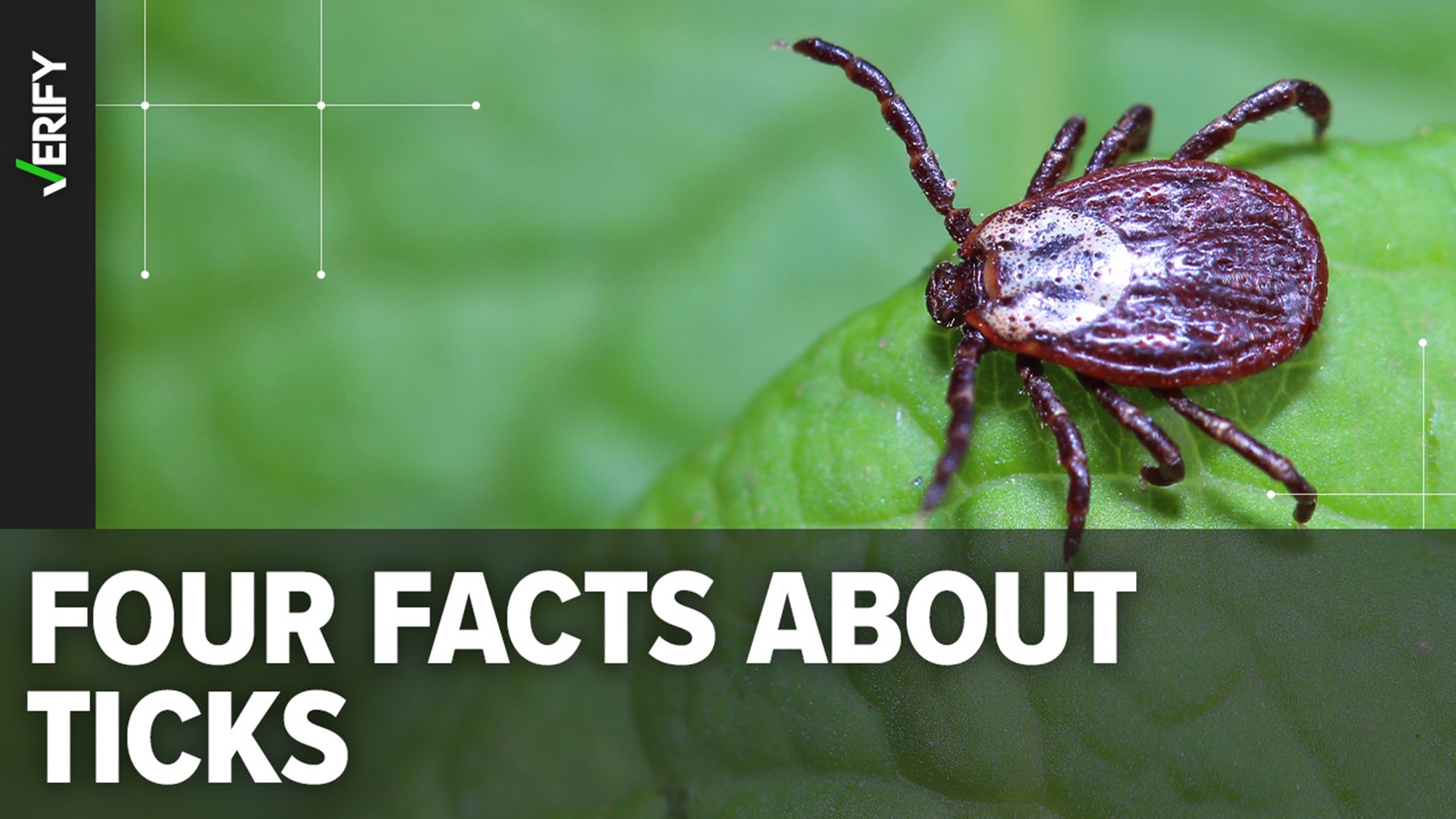Ticks are parasites that feed on people or other mammals by biting them. People can be exposed to ticks year-round, but these pesky critters are most active during the summertime.
We VERIFY four fast facts about ticks and how you can avoid getting bitten.
THE SOURCES
- Centers for Disease Control and Prevention (CDC)
- Cleveland Clinic
- Illinois Department of Public Health
- PestWorld.org, the official website of the National Pest Management Association (NPMA)
- Nemours Children's Health
- OSF HealthCare
- Kansas State University
- Bellevue Animal Hospital in Bellevue, Nebraska
- PetMD
- Consumer Reports
- Kirsten Crandall, Ph.D. candidate in the department of biology at McGill University
QUESTION #1
Are ticks insects?
ANSWER #1
No, ticks are not insects — they’re arachnids.
WHAT WE FOUND
Although many believe ticks are insects, they’re actually classified as arachnids, like scorpions, spiders and mites, according to the Illinois Department of Public Health, PestWorld.org and Nemours Children's Health.
The Illinois Department of Public Health explains that adult ticks, like other arachnids, have four pairs of legs, no antennae and they don’t fly. Their body design, combined with their feeding needs for each part of their life cycle, determines how ticks get to their host to feed. A tick’s life cycle consists of four stages: egg, larva, nymph and adult, according to PetMD.
There are hundreds of kinds of ticks but the deer tick and dog tick are the most common in the United States, Nemours Children’s Health says. Deer ticks are about the size of the head of a pin, while dog ticks can be up to one-half of an inch.
QUESTION #2
Do ticks fall or jump from trees?
ANSWER #2
No, ticks don’t fall or jump from trees.
WHAT WE FOUND
Contrary to popular belief, ticks don’t fall, jump or drop down from trees onto people. Instead, ticks live on the ground and migrate up a host before biting them, according to Kansas State University, OSF HealthCare and Kirsten Crandall, a Ph.D. candidate at McGill University.
“Many people described having ticks jumping on them from trees, but ticks can’t jump. Instead, they patiently sit on low vegetation or crawl around the ground, sensing a host’s carbon dioxide and heat,” Crandall said.
OSF HealthCare says people typically encounter ticks in their yards or while walking in fields or wooded areas with tall grass or foliage. If you’re in a high-risk tick area, OSF HealthCare recommends making a clothing barrier to keep the ticks away from the skin by tucking your pant legs into your socks and your shirt into your belt.
QUESTION #3
Are tweezers the best way to remove ticks?
ANSWER #3
Yes, tweezers are the best way to remove ticks.
WHAT WE FOUND
The CDC, OSF HealthCare, Bellevue Animal Hospital and Ph.D. candidate Kirsten Crandall all recommend using a clean pair of fine-tipped tweezers to quickly and safely remove a tick from the skin by grasping as close to the skin as possible and slowly pulling upward with steady, even pressure.
“Don’t twist or jerk the tick; this can cause the mouth-parts to break off and remain in the skin. If this happens, remove the mouth parts with tweezers. If you cannot remove the mouth easily with tweezers, leave it alone and let the skin heal,” the CDC says on its website.
The CDC says you can dispose of a live tick by putting it in alcohol, placing it in a sealed bag or container, wrapping it tightly in tape or flushing it down the toilet. But you should never crush a tick with your fingers because they could contain potentially infected blood.
After removal, you should wash the bite location and your hands with rubbing alcohol or soap and water, and monitor for symptoms. If you develop a rash or fever within several weeks of removing a tick, you should contact your healthcare provider.
Some people believe that ticks are best removed by coating them with fingernail polish or petroleum jelly or by applying heat with a lit match to make the tick detach from the skin, but all of our sources advise against trying any of these potentially dangerous tick removal methods.
“You are more likely to contract a disease using these methods because a tick can regurgitate its content — like bacteria and viruses — into you before dying,” Crandall said.
QUESTION #4
Is Lyme disease the only tick-borne illness?
ANSWER #4
No, Lyme disease is not the only tick-borne illness.
WHAT WE FOUND
Lyme disease is the most common and well-known tick-borne disease in the U.S. But the Centers for Disease Control and Prevention (CDC) and OSF HealthCare both say ticks transmit several other diseases.
Lyme disease is generally caused by the Borrelia burgdorferi bacterium, and it is transmitted to humans through the bite of infected blacklegged (deer) ticks, according to the CDC. Typical symptoms of Lyme disease include fever, headache, fatigue and a characteristic skin rash called erythema migrans, which looks similar to a bullseye or target.
The CDC says that most cases of Lyme disease can usually be treated successfully with a few weeks of antibiotics. But, if left untreated, the infection can spread to joints, the heart and the nervous system.
In addition to Lyme disease, ticks can also transmit other tick-borne diseases to humans, such as anaplasmosis, borrelia miyamotoi, Bourbon virus, heartland virus, Rocky Mountain spotted fever and tularemia. Click here to read more about other tick-borne diseases.
The CDC shares tips on how people and pets can avoid tick bites and prevent Lyme disease and other tick-borne diseases on its website. Those tips include:
Before you go outside
- Know where to expect ticks. Ticks live in grassy, brushy, or wooded areas, or even on animals. Spending time outside walking your dog, camping, gardening or hunting could bring you in close contact with ticks. Many people get ticks in their own yards or neighborhood.
- Treat clothing and gear with products containing 0.5% permethrin. Permethrin can be used to treat boots, clothing and camping gear, and they’ll remain protected through several washings. Alternatively, you can buy permethrin-treated clothing and gear.
- Use EPA-registered insect repellents containing DEET, picaridin, IR3535, oil of lemon eucalyptus (OLE), para-menthane-diol (PMD) or 2-undecanone. The EPA’s helpful search tool can help you find the product that best suits your needs. Always follow product instructions. Do not use products containing OLE or PMD on children under 3 years old.
- Avoid contact with ticks. Try to avoid wooded and brushy areas with high grass and leaf litter, and make sure you walk in the center of trails.
After you come back inside
- Check your clothing for ticks. Ticks may be carried into the house on clothing. Any ticks that are found should be removed. Tumble dry clothes in a dryer on high heat for 10 minutes to kill ticks on dry clothing after you come indoors. If the clothes are damp, additional time may be needed. If the clothes require washing first, hot water is recommended. Cold and medium-temperature water will not kill ticks.
- Examine gear and pets. Ticks can ride into the home on clothing and pets, then attach to a person later, so carefully examine pets, coats and daypacks.
- Shower soon after being outdoors. Showering within two hours of coming indoors has been shown to reduce your risk of getting Lyme disease and may be effective in reducing the risk of other tick-borne diseases. Showering may help wash off unattached ticks, and it is a good opportunity to do a tick check.
- Check your body for ticks. Conduct a full body check upon return from potentially tick-infested areas, including your own backyard. Use a hand-held or full-length mirror to view all parts of your body. Check these parts of your body and your child’s body for ticks: Under the arms, in and around the ears, inside the belly button, back of the knees, in and around the hair, between the legs and around the waist.












